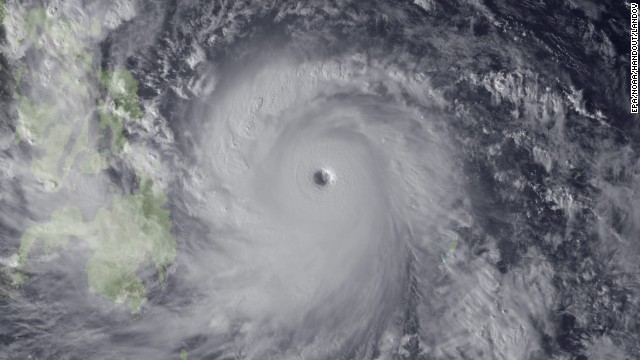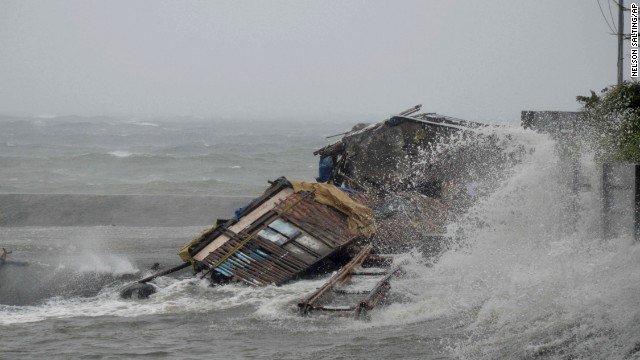Join Date: Mar 2011
Location: In The Hills of Tennessee
Posts: 6,631
Thanks: 7,332
Thanked 7,261 Times in 4,751 Posts
|
 re: PhOtOs-Aftermath of SuperTyphoon=10,000+ Dead in Philippines
re: PhOtOs-Aftermath of SuperTyphoon=10,000+ Dead in Philippines
UPDATE: Super Typhoon Haiyan, perhaps strongest ever, plows across Philippines
Updated 8:48 AM EST, Fri November 8, 2013

Super Typhoon Haiyan makes landfall
Super Typhoon Haiyan -- perhaps the strongest storm ever -- plowed Friday across the central Philippines, leaving widespread devastation in its wake.
It roared onto Samar at 4:30 a.m., flooding streets and knocking out power and communications networks in many areas of the hilly island in the region of Eastern Visayas, and then continued its march, barreling into four other Philippine islands as it moved across the archipelago.
At least three people were killed and seven hurt, the National Disaster Risk Reduction and Management Council said Friday. Some 125,000 took refuge in evacuation centers and hundreds of flights were canceledWith sustained winds of 315 kph (195 mph) and gusts as strong as 380 kph (235 mph), Haiyan may be the strongest tropical cyclone to hit land anywhere in recorded history. It will take further analysis after the storm passes to establish whether it is a record.
Its speed -- moving westward at 41 kph -- meant the worst was over quickly. But the damage was still severe. "About 90% of the infrastructure and establishments were heavily damaged," Gwendolyn Pang, the secretary general of the Philippine National Red Cross, told CNNI.
About 25 areas were hit, she said, adding that assessment teams were prepared to enter the stricken areas as soon as conditions allowed.
But they cannot do it alone, she said: "We will be definitely needing more support for this one."
She predicted the casualty toll will rise as soon as aid workers reach affected areas, where flood waters were as high as 10 feet.
Maryann Zamora, a field communications specialist for the charity World Vision, said her organization "has been working through so many disasters, so many typhoons -- but this is quite different."
"This is the strongest I ever felt so far," she said by phone from the island of Cebu.
Haiyan, known in the Philippines as Yolanda, retained much of its force as it moved westward with sustained winds of 295 kph (185 mph), which puts it well above the 252 kph threshold for a Category 5 hurricane, the highest category on the Saffir--Simpson hurricane wind scale.
Video showed streets flooded with debris and sheets of metal flying through the air.
Gov. Roger Mercado of Southern Leyte, a province in Eastern Visayas near the storm's path, said Friday morning that fallen trees had made impassable all roads. "We don't know the extent of the damage," Mercado said. "We are trying to estimate this. We are prepared, but this is really a wallop."
With sea travel suspended in many areas, more than 3,000 travelers were stranded in ports, the council said.
The typhoon was forecast to move away from the Philippines late Friday or early Saturday and head into the South China Sea in the direction of Vietnam.
Meteorologists predicted that it would maintain super typhoon intensity throughout its passage over the Philippines. A super typhoon has surface winds that sustain speeds of more than 240 kph (150 mph) for at least a minute, according to the U.S. National Oceanic and Atmospheric Administration.
Haiyan was so large in diameter that, at one point, its clouds were affecting two-thirds of the country, which stretches more than 1,850 kilometers (1,150 miles). Tropical-storm-force winds extended 240 kilometers from the typhoon's center.
 Ahead of the typhoon's arrival, thousands of people had been relocated away from particularly vulnerable areas in the city of Tacloban, which is situated in a coastal area of the region that bore the initial brunt of the storm.
Communications with Tacloban, which has a population of around 200,000, were disrupted after the typhoon struck. Video aired by CNN affiliate ABS-CBN showed streets in the city filled with water and debris.
In a speech Thursday, President Benigno S. Aquino III warned residents of the "calamity our countrymen will face in these coming days."
"This is a very real danger, and we can mitigate and lessen its effects if we use the information available to prepare," he said.
Authorities had aircraft ready to respond, and officials had placed relief supplies in the areas that were expected to get hit, Aquino said.
"The effects of this storm can be eased through solidarity," he said.
Earthquake survivors vulnerable
Authorities warned people in provinces across the country to prepare for possible flash floods, landslides and a storm surge as high as 7 meters (23 feet). About 125,000 people nationwide were moved to evacuation centers.
Among the most vulnerable were people living in tents on the central Philippine island of Bohol, killing at least 222 people, injuring nearly 1,000 and displacing about 350,000, according to authorities.
On Friday, they got a second jolt -- this time from the typhoon's winds and rain, but they were spared a direct hit.
"For the past three weeks people are still experiencing aftershocks," said Aaron Aspi, a communications specialist in Bohol for World Vision. "And at the same time, these rains are giving them a really hard time."
Aspi said that, despite living in drenched tents, many people were afraid to relocate to sturdier structures because of the aftershocks.
Another island near the storm's path was the popular beach resort of Boracay. Some tourists there cut short vacations on Thursday to get away from the possible danger.
Situated near an area of the Pacific Ocean where tropical cyclones form, the Philippines regularly suffers severe storm damage.
An average of 20 typhoons hit the nation every year.
In December, Typhoon Bopha wreaked devastation on the southern Philippine island of Mindanao. The storm, the most powerful to hit the country last year, is estimated to have killed as many as 1,900 people.
Ahead of the typhoon's arrival, thousands of people had been relocated away from particularly vulnerable areas in the city of Tacloban, which is situated in a coastal area of the region that bore the initial brunt of the storm.
Communications with Tacloban, which has a population of around 200,000, were disrupted after the typhoon struck. Video aired by CNN affiliate ABS-CBN showed streets in the city filled with water and debris.
In a speech Thursday, President Benigno S. Aquino III warned residents of the "calamity our countrymen will face in these coming days."
"This is a very real danger, and we can mitigate and lessen its effects if we use the information available to prepare," he said.
Authorities had aircraft ready to respond, and officials had placed relief supplies in the areas that were expected to get hit, Aquino said.
"The effects of this storm can be eased through solidarity," he said.
Earthquake survivors vulnerable
Authorities warned people in provinces across the country to prepare for possible flash floods, landslides and a storm surge as high as 7 meters (23 feet). About 125,000 people nationwide were moved to evacuation centers.
Among the most vulnerable were people living in tents on the central Philippine island of Bohol, killing at least 222 people, injuring nearly 1,000 and displacing about 350,000, according to authorities.
On Friday, they got a second jolt -- this time from the typhoon's winds and rain, but they were spared a direct hit.
"For the past three weeks people are still experiencing aftershocks," said Aaron Aspi, a communications specialist in Bohol for World Vision. "And at the same time, these rains are giving them a really hard time."
Aspi said that, despite living in drenched tents, many people were afraid to relocate to sturdier structures because of the aftershocks.
Another island near the storm's path was the popular beach resort of Boracay. Some tourists there cut short vacations on Thursday to get away from the possible danger.
Situated near an area of the Pacific Ocean where tropical cyclones form, the Philippines regularly suffers severe storm damage.
An average of 20 typhoons hit the nation every year.
In December, Typhoon Bopha wreaked devastation on the southern Philippine island of Mindanao. The storm, the most powerful to hit the country last year, is estimated to have killed as many as 1,900 people.
__________________
 Rock Out With DreamTeamDownloads1-The Best Place To Be For Downloads.
You Can Help the site If You Donate, Please Click Here: DONATE
Thank You For Your Support & Membership To DTD1. Rock Out With DreamTeamDownloads1-The Best Place To Be For Downloads.
You Can Help the site If You Donate, Please Click Here: DONATE
Thank You For Your Support & Membership To DTD1.
|